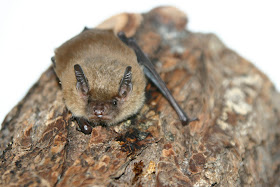 |
| Photo of healthy big brown bat, courtesy Dawn Vezina at the Organization for Bat Conservation |
If you love the taste of fresh vegetables, hate mosquito bites and appreciate a balanced environment, then you might want to go batty. My husband thinks I've gone batty, because I've been asking him for nearly two years now to help me install the bat house that I purchased online. It wasn't cheap. After his inspection, my husband declared that the wooden structure would eventually fall apart unless he sealed it with some varnish. He's debated with me about the perfect location for it. He's deflected my threats to call a lumberjack to climb a tree and install it for me, unless we can do it ourselves. I am determined to give my local bats a house! This one has a nylon mesh for the bats to hold onto with their tiny toenails, multiple roosting compartments and a ventilation slat.
Did you know that bats can eat at least a third of their body weight in insects every night? The Organization for Bat Conservation credits bats with protecting crops from pests such as root-worms. Without them, farmers and gardeners would have many more pests to contend with. Bats sound like a natural alternative to those of us wary about pesticides. Since a single bat can eat mosquitoes by the hundreds and thousands, can you imagine how many more mosquitoes we would have without these nocturnal creatures? I'm hopeful that a house will entice even more bats to hang out and feed on the mosquitoes around my yard.
Sure, you have to be cautious in the unlikely event that a bat gets too friendly. We won't be mounting the bat house directly on our house for that reason. We tell the kids to never touch a bat if they see one on the ground. Yet, the statistical likelihood of a deadly serious rabid bat bite is much lower than the hype about it.
A much more common occurrence over the past few years is a disease that has killed a million bats in the Northeastern United States. Called white-nose syndrome, the mysterious fungal infection was first discovered in bat populations in upstate New York. Scientists think the disease threatens bat health by disrupting normal hibernation patterns.
As the bats start to stir again after hibernation in East Tennessee, scientists with the Tennessee Wildlife Resources Agency are visiting caves to see how bats are surviving there. This is one of several states now seeing the spread of white-nose syndrome. Officials think the disease not only spreads from bat to bat, but possibly from cave to cave via human visitors. All caves on public lands in Tennessee are closed to the public, as a precaution. "We ask that people stay out of caves," stresses Scott Dykes, a TWRA biologist. Dykes says that when TWRA cavers go on official business, they follow a strict protocol of disinfecting their gear to limit the spread of the fungus. Dykes says at least so far, bat casualties have been low in Tennessee compared to some northern states.
So, it's not enough that bats are maligned in vampire movies, jokes and silly blog headlines. Now, they face what one wildlife official called a "devastating disease" in white-nose syndrome. The US Fish and Wildlife Service has a map tracking the spread of white-nose syndrome in bats. The Organization for Bat Conservation has educational materials, sells bat houses, and offers free plans for building your own bat house. Sounds like we need healthy bats to keep things in balance and to limit mosquito bites on warm summer evenings.


Thank you so much for this post! I read it earlier and I just talked to my husband about it, and we are going to work on building a bat house soon! We live in NC, and the mosquitoes nearly kill me every summer. I had already started brain storming on ways to combat them this year, and I think a bat house would provide a great natural alternative to help control the mosquitoes.
ReplyDelete